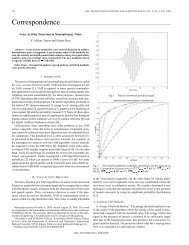Thesis (PDF) - Signal & Image Processing Lab
Thesis (PDF) - Signal & Image Processing Lab
Thesis (PDF) - Signal & Image Processing Lab
You also want an ePaper? Increase the reach of your titles
YUMPU automatically turns print PDFs into web optimized ePapers that Google loves.
22 CHAPTER 2. THEORETICAL BACKGROUND<br />
Definition 4. Given a complete inf-semilattice S, define the set US of upper-bounded<br />
subsets of S as follows:<br />
US � {S ′ ⊂ S|(∃Y0 ∈ S|Y0 ≥ X, ∀X ∈ S ′ )} (2.6)<br />
In words, US contains all the subsets of S that have a majorant Y0. Supremum is<br />
defined only over elements of US.<br />
Proposition 4. The least majorant (supremum) ∨B of a set B ⊂ S exists iff B ∈ US,<br />
in which case it is equal to:<br />
∨B = � {Y ∈ S|Y ≥ X, ∀X ∈ B} (2.7)<br />
The above supremum is well defined over and only over US. This is because the<br />
set {Y ∈ S|Y ≥ X, ∀X ∈ B} is non-empty iff B ∈ US. In summary, if a subset of the<br />
complete inf-semilattice has a majorant, then it has a least majorant, and this is the<br />
supremum.<br />
Dilation<br />
Instead of defining dilation generically (as an operator that commutes with the supre-<br />
mum), Keshet defines in [21] the adjoint dilation of a given erosion, restricted to a<br />
sub-domain of the semilattice. Before presenting the definition of dilation, let us<br />
characterize the domain.<br />
Definition 5. Given an erosion ε in a complete inf-semilattice S, we define the set<br />
of ε − bounded elements of S, symbolized by Sε, as:<br />
Sε � {Y ∈ S|[∃X ∈ S|Y ≤ ε(X)]} (2.8)<br />
In words, Sε contains the elements in S that are smaller or equal to the erosion<br />
of some element in S. This is the domain for the adjoint dilation of the erosion, as<br />
defined below.<br />
Definition 6. (Adjoint Dilation) Let S be a complete inf-semilattice, and ε an ero-<br />
sion. If X ∈ Sε, then the adjoint dilation of ε, denoted δε, is defined as:<br />
δε = � {Y ∈ S|X ≤ ε(Y )} (2.9)
















